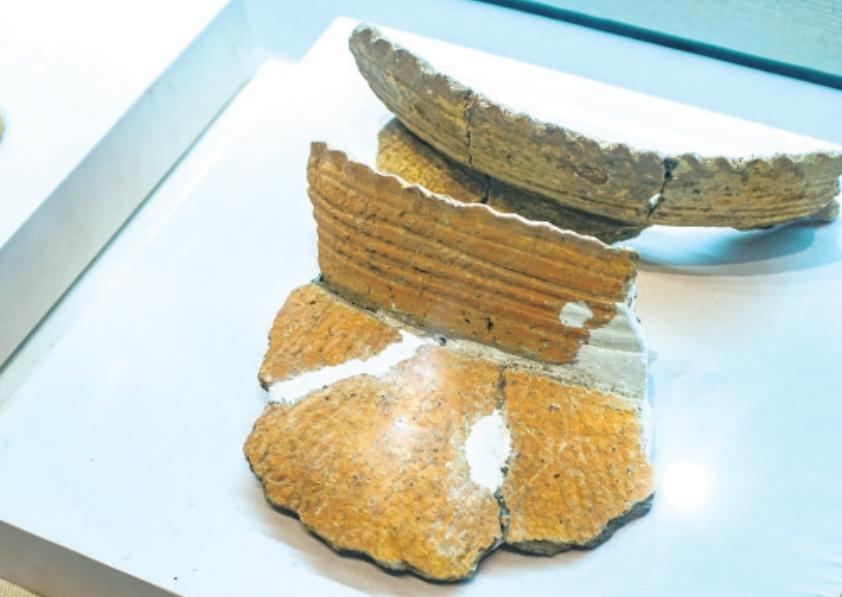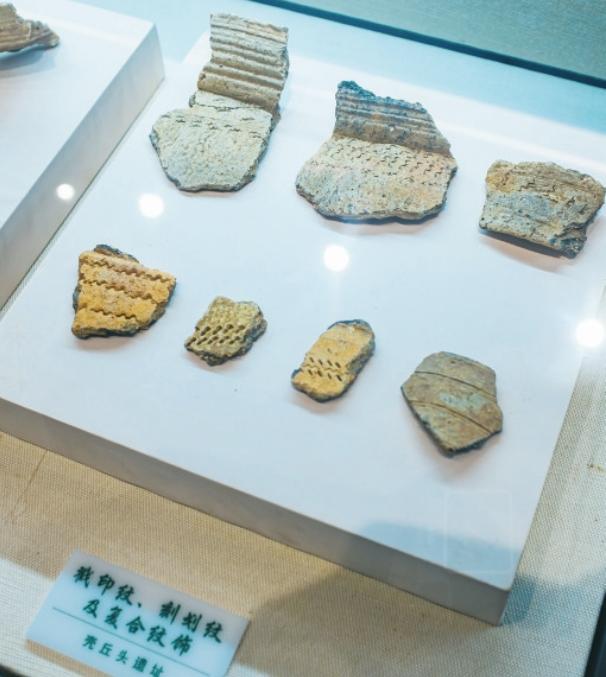Ornamental Pottery: Engraving symbols of shared cultural heritage
Updated:2025-05-19 | Lin Kongbo, Stephanie
A gray-brown pottery with coarse sand mixed in, imprinted with cord marks and shell-impressed patterns

Pottery shards with stamp impressions, incisions, and composite decorations
Name: Shell-imprinted pottery, Cord-marked pottery
Excavation Sites: Keqiutou site, Gushan site, and others
Function: Daily utensils
Era: Neolithic Period
Age: Approximately 6,500 years, 5,000–3,000 years
Archaeological Findings:
The artifacts show the evidence of cultural connections during the Neolithic Period on both sides of the Taiwan Straits.
According to the information, most of these artifacts are sand-tempered pottery unearthed from the Keqiutou site, characterized by typical surface decorations like shell-impressed patterns, punctate designs, engraved parallel lines, and short diagonal or floral impressions on the lip edges. The vessel types include round-bottomed, ring-footed, and flat-bottomed pots, with parallel lines engraved on the outer rims, concave inner surfaces, and wavy lips.
"Similar artifacts have been found in the lower cultural layers of the Xitou site in Minhou, the Fuguodun site in Kinmen, and, notably, there are resemblances to the Dabenkeng Culture in Taiwan, indicating cultural connections between the Neolithic Period on both sides of the Taiwan Straits," said Hou Ronggui, deputy director of the Pingtan International Austronesian Research Institute.
Examining the pottery's color, the clay pottery mainly appears gray, along with shades of black, gray-yellow, red, and brown, while purely red pottery is rare. Hou Ronggui explained that limited conditions back then resulted in low firing temperatures, leaving most pottery bodies gray or blackish-gray. In terms of crafting techniques, the ancestors used a coiling method to build the pots, attaching the vessel body to the rim. The neck was reinforced by pressing with tools, leaving behind traces of pressing instruments like small wooden sticks or shells. The rims were then refined using a slow wheel, leaving clear rotational marks.
"Shell-impressed patterns are a distinctive feature of marine culture utensils," Hou Ronggui noted. This decorative method, called short diagonal or floral impressions on the lip edges, was a common technique. The ancestors used shells, mainly the edges of mud cockles, to directly imprint on the pottery surface, usually decorating the vessels in groups, with some pieces even showing fingernail impressions. The punctate designs, consisting of various dotted patterns, were typically arranged in rows or continuous lines, with shapes ranging from oval, rectangular, and circular to triangular or irregular forms. The perforated decorations included triangular, circular, and elongated shapes, while the stamped designs, known as hemp marks, also appeared.
The clay pottery's decorative elements were concentrated on the base, mainly featuring perforations and punctate marks. Some rims were uniquely petal-shaped, presenting a distinctive style. The inner walls of the vessels were often uneven or displayed distinct depressions, and some pieces retained imprints of stems and leaves, left either during crafting and refining or when decorating the surface.
At the Gushan site, dating back around 4,000 to 3,200 years ago, sand-tempered pottery dominated the finds, along with some clay pottery, impressed ware, red-slipped pottery, and a small amount of proto-porcelain. The pottery surfaces featured cord marks, string patterns, punctate designs, as well as geometric designs like checkerboard patterns, cloud and thunder patterns, spirals, and engraved lines. "These large numbers of grouped and restored pottery pieces provide crucial data for establishing the cultural identity of the Gushan site and its place in the prehistoric cultural development of the southeastern coast of Fujian. This forms a solid material foundation," said Hou Ronggui.
Additional context:
Pottery is one of the key indicators of humanity's entry into the Neolithic Age. Pottery-making first emerged around 10,000 years ago. The rise of the pottery industry led to more stable settlements, as different types of pottery facilitated cooking, water storage, and other daily needs, making life more convenient and enhancing productivity. If fire use in the Paleolithic Age marked a significant shift in human survival, the advent of pottery signified the mastery of fire's full potential, greatly advancing the ability to exploit natural resources and create new materials.
Early pottery-making was quite primitive, with simple shapes, loose textures, and minimal decoration. About 7,000 years ago, pottery-making saw significant progress, adopting techniques like slab construction, pinching, and coiling, with higher firing temperatures, though decoration remained simple. After 5,000 years ago, the use of the fast wheel for pottery production became widespread. In northern China, red clay was commonly used for pottery, while in the south, high-alumina clay became the primary material.

